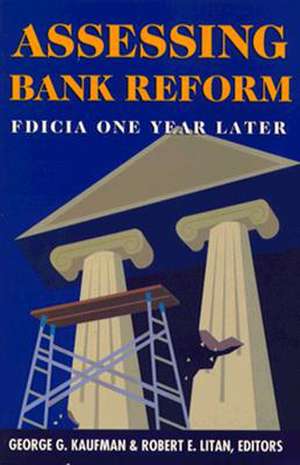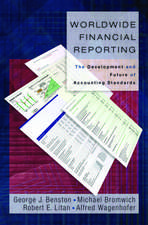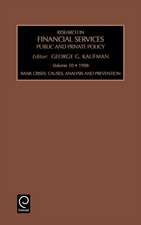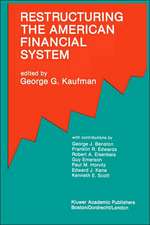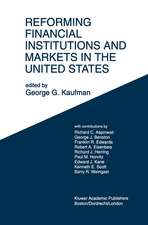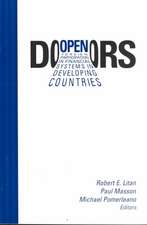Assessing Bank Reform: FDICIA One Year Later
Editat de George G. Kaufman, Robert E. Litanen Limba Engleză Paperback – aug 1993
The last decade has been both traumatic and revolutionary for the U.S. banking industry. In late 1990 and early 1991, the outlook for the banking industry and even the federal insurance fund that backs most of its deposits looked especially bleak. Several independent analysts, congressional watchdog agencies, and the federal government itself warned that the large number and size of bank failures would exhaust the resources of the Federal Deposit Insurance Corporation for resolving bank failures and paying off their depositors.
Amid extensive proposals for deposit insurance reform, Congress enacted the Federal Deposit Insurance Corporation Improvement Act (FDICIA), one of the most important and controversial pieces of banking legislation of the last fifty years.
In December 1992, Brookings sponsored a conference, in conjunction with the Chicago Clearing House Association, to mark the first anniversary of FDICIA and to assess its impact.
This book features the papers presented at the conference and a summary of the discussion of the more than 150 participants. Representatives with diverse viewpoints met to consider and debate the wisdom of FDICIA and of future banking policy. The authors include leading academic scholars, current and former policymakers, and experts from the private sector. Their papers cover the intellectual and political history of the Act, how the Act was being implemented, responses of regulators and banks to the Act, and how banking regulatory and legislative policy should proceed. The book concludes with recommendations for future banking regulatory and legislative policy.
In addition to editors Kaufman and Litan, the contributors are James E. Annable, First National Bank of Chicago; Richard C. Aspinwill, Chase Manhattan Bank; Richard Scott Carnell, Senate Banking Committee; Anthony Downs, Brookings; Robert E. Glauber, Harvard University; William S. Haraf, Citicorp; W. Lee Hoskins, Huntington National Bank; Edward J. Kane, Boston College; Congressman Jim Leach, ranking minority member of the House Banking Committee; David W. Mullins, Jr., vice-chairman of the Federal Reserve Board; Kenneth E. Scott, Stanford Law School; Karen D. Shaw, Institute for Strategy Development; Barbara Timmer, former General Counsel, House Banking Committee, and Jay M. Weintraub, Merrill Lynch.
Amid extensive proposals for deposit insurance reform, Congress enacted the Federal Deposit Insurance Corporation Improvement Act (FDICIA), one of the most important and controversial pieces of banking legislation of the last fifty years.
In December 1992, Brookings sponsored a conference, in conjunction with the Chicago Clearing House Association, to mark the first anniversary of FDICIA and to assess its impact.
This book features the papers presented at the conference and a summary of the discussion of the more than 150 participants. Representatives with diverse viewpoints met to consider and debate the wisdom of FDICIA and of future banking policy. The authors include leading academic scholars, current and former policymakers, and experts from the private sector. Their papers cover the intellectual and political history of the Act, how the Act was being implemented, responses of regulators and banks to the Act, and how banking regulatory and legislative policy should proceed. The book concludes with recommendations for future banking regulatory and legislative policy.
In addition to editors Kaufman and Litan, the contributors are James E. Annable, First National Bank of Chicago; Richard C. Aspinwill, Chase Manhattan Bank; Richard Scott Carnell, Senate Banking Committee; Anthony Downs, Brookings; Robert E. Glauber, Harvard University; William S. Haraf, Citicorp; W. Lee Hoskins, Huntington National Bank; Edward J. Kane, Boston College; Congressman Jim Leach, ranking minority member of the House Banking Committee; David W. Mullins, Jr., vice-chairman of the Federal Reserve Board; Kenneth E. Scott, Stanford Law School; Karen D. Shaw, Institute for Strategy Development; Barbara Timmer, former General Counsel, House Banking Committee, and Jay M. Weintraub, Merrill Lynch.
Preț: 180.71 lei
Nou
Puncte Express: 271
Preț estimativ în valută:
34.58€ • 36.19$ • 28.78£
34.58€ • 36.19$ • 28.78£
Carte tipărită la comandă
Livrare economică 31 martie-14 aprilie
Preluare comenzi: 021 569.72.76
Specificații
ISBN-13: 9780815748731
ISBN-10: 0815748736
Pagini: 168
Dimensiuni: 152 x 229 x 13 mm
Greutate: 0.26 kg
Ediția:New.
Editura: Brookings Institution Press
Colecția Brookings Institution Press
ISBN-10: 0815748736
Pagini: 168
Dimensiuni: 152 x 229 x 13 mm
Greutate: 0.26 kg
Ediția:New.
Editura: Brookings Institution Press
Colecția Brookings Institution Press
Notă biografică
Robert E. Litan is a senior fellow in Economic Studies at the Brookings Institution and vice president for research and policy at the Kauffman Foundation. Among his many books is Good Capitalism, Bad Capitalism, and the Economics of Growth and Prosperity (Yale University Press, 2007), written with William J. Baumol and Carl J. Schramm. George G. Kaufman is the John F. Smith Professor of Finance and Economics at Loyala University of Chicago. Among his many books is The U.S. Financial System: Money, Markets, and Institutions (Prentice-Hall, 1992).
Descriere
The last decade has been both traumatic and revolutionary for the U.S. banking industry. In late 1990 and early 1991, the outlook for the banking industry and even the federal insurance fund that backs most of its deposits looked especially bleak. Several independent analysts, congressional watchdog agencies, and the federal government itself warned that the large number and size of bank failures would exhaust the resources of the Federal Deposit Insurance Corporation for resolving bank failures and paying off their depositors.
Amid extensive proposals for deposit insurance reform, Congress enacted the Federal Deposit Insurance Corporation Improvement Act (FDICIA), one of the most important and controversial pieces of banking legislation of the last fifty years.
In December 1992, Brookings sponsored a conference, in conjunction with the Chicago Clearing House Association, to mark the first anniversary of FDICIA and to assess its impact.
This book features the papers presented at the conference and a summary of the discussion of the more than 150 participants. Representatives with diverse viewpoints met to consider and debate the wisdom of FDICIA and of future banking policy. The authors include leading academic scholars, current and former policymakers, and experts from the private sector. Their papers cover the intellectual and political history of the Act, how the Act was being implemented, responses of regulators and banks to the Act, and how banking regulatory and legislative policy should proceed. The book concludes with recommendations for future banking regulatory and legislative policy.
In addition to editors Kaufman and Litan, the contributors are James E. Annable, First National Bank of Chicago; Richard C. Aspinwill, Chase Manhattan Bank; Richard Scott Carnell, Senate Banking Committee; Anthony Downs, Brookings; Robert E. Glauber, Harvard University; William S. Haraf, Citicorp; W. Lee Hoskins, Huntington National Bank; Edwar
Amid extensive proposals for deposit insurance reform, Congress enacted the Federal Deposit Insurance Corporation Improvement Act (FDICIA), one of the most important and controversial pieces of banking legislation of the last fifty years.
In December 1992, Brookings sponsored a conference, in conjunction with the Chicago Clearing House Association, to mark the first anniversary of FDICIA and to assess its impact.
This book features the papers presented at the conference and a summary of the discussion of the more than 150 participants. Representatives with diverse viewpoints met to consider and debate the wisdom of FDICIA and of future banking policy. The authors include leading academic scholars, current and former policymakers, and experts from the private sector. Their papers cover the intellectual and political history of the Act, how the Act was being implemented, responses of regulators and banks to the Act, and how banking regulatory and legislative policy should proceed. The book concludes with recommendations for future banking regulatory and legislative policy.
In addition to editors Kaufman and Litan, the contributors are James E. Annable, First National Bank of Chicago; Richard C. Aspinwill, Chase Manhattan Bank; Richard Scott Carnell, Senate Banking Committee; Anthony Downs, Brookings; Robert E. Glauber, Harvard University; William S. Haraf, Citicorp; W. Lee Hoskins, Huntington National Bank; Edwar
